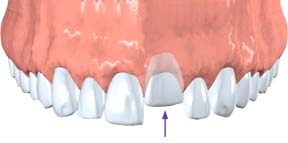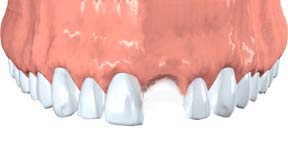 During an injury, a tooth may be pushed sideways, out of or into its socket. Your endodontist or general dentist will reposition and stabilize your tooth. Endodontic Therapy (root canal treatment) is usually needed for permanent teeth that have been dislodged and should be started a few days following the injury. Medication such as calcium hydroxide may be put inside the tooth as part of the Endodontic Therapy (root canal treatment). A permanent root canal filling will be placed at a later date.
During an injury, a tooth may be pushed sideways, out of or into its socket. Your endodontist or general dentist will reposition and stabilize your tooth. Endodontic Therapy (root canal treatment) is usually needed for permanent teeth that have been dislodged and should be started a few days following the injury. Medication such as calcium hydroxide may be put inside the tooth as part of the Endodontic Therapy (root canal treatment). A permanent root canal filling will be placed at a later date.
 Children between seven and 12 years old may not need Endodontic Therapy (root canal treatment) since their teeth are still developing. For those patients, an endodontist or dentist will monitor the healing carefully and intervene immediately if any unfavorable changes appear. Therefore, multiple follow-up appointments are likely to be needed. New research indicates that stem cells present in the pulps of young people can be stimulated to complete root growth and heal the pulp following injuries or infection.
Children between seven and 12 years old may not need Endodontic Therapy (root canal treatment) since their teeth are still developing. For those patients, an endodontist or dentist will monitor the healing carefully and intervene immediately if any unfavorable changes appear. Therefore, multiple follow-up appointments are likely to be needed. New research indicates that stem cells present in the pulps of young people can be stimulated to complete root growth and heal the pulp following injuries or infection.
If a tooth is completely knocked out of your mouth, time is of the essence. The tooth should be handled very gently, avoiding touching the root surface itself. If it is dirty, quickly and gently rinse it in water. Do not use soap or any other cleaning agent, and never scrape or brush the tooth. If possible, the tooth should be placed back into its socket as soon as possible. The less time the tooth is out of its socket, the better the chance for saving it. Call a dentist immediately!
 If you cannot put the tooth back in its socket, it needs to be kept moist in special solutions that are available at many local drugstores (such as Save-A-Tooth). If those solutions are unavailable, you should put the tooth in milk. Doing this will keep the root cells in your tooth moist and alive for a few hours. Another option is to simply put the tooth in your mouth between your gum and cheek. Do not place the tooth in regular tap water because the root surface cells do not tolerate it.
If you cannot put the tooth back in its socket, it needs to be kept moist in special solutions that are available at many local drugstores (such as Save-A-Tooth). If those solutions are unavailable, you should put the tooth in milk. Doing this will keep the root cells in your tooth moist and alive for a few hours. Another option is to simply put the tooth in your mouth between your gum and cheek. Do not place the tooth in regular tap water because the root surface cells do not tolerate it.
Once the tooth has been put back in its socket, your dentist will evaluate it and will check for any other dental and facial injuries. If the tooth has not been placed back into its socket, your dentist will clean it carefully and replace it. A stabilizing splint will be placed for a few weeks. Depending on the stage of root development, your dentist or endodontist may start Endodontic Therapy (root canal treatment) a week or two later. A medication may be placed inside the tooth followed by a permanent root canal filling at a later date.
The length of time the tooth was out of the mouth and the way the tooth was stored before reaching the dentist influence the chances of saving the tooth. Again, immediate treatment is essential. Taking all these factors into account, your dentist or endodontist may discuss other treatment options with you.

